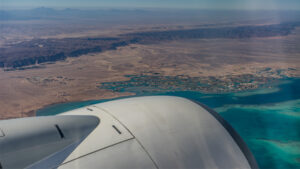Flying connects people from different cultures around the world, but, for all the good that it does, air travel also negatively impacts our environment through carbon emissions.
Here in the U.S., we emit more carbon dioxide through air travel than any other nation.
According to the International Air Transport Association, the global aviation industry is responsible for around 2 percent of carbon dioxide emissions. As air traffic continues to increase, so too will the damage to our climate.
If the recent transatlantic crossing by climate change activist Greta Thunberg has given you cause to consider the impact your own travel has on the climate, there’s plenty you can do to reduce your own carbon footprint. These suggestions from our friends at bag storage service LuggageHero are an excellent place to start.
Rethink Short Flights if Possible
If you’re traveling between New York and Washington D.C., Dallas and Houston, or Los Angeles and San Francisco, or other near-ish cities, opt for road or rail transportation instead of flying. Sure, it’ll probably tack on a few extra hours to the trip, but you’ll lower your carbon dioxide emissions.
Trips under 600 miles are more energy efficient with a train, bus, or driving.
Related: Vacation Heat Wave: 11 Must-Have Items to Keep You Cool When Traveling
Go for the Nonstop Flight
It may cost a little extra, but flying nonstop is better for the environment. Not only does it save you valuable time by sparing you a connection, but one flight uses less energy than two. Planes use around 25% of fuel during takeoff and are much more fuel-efficient once cruising altitude is reached.
Super Long Flights Require More Fuel
Obviously, a very long flight will require more fuel, and all that fuel adds weight to the plane, making it less energy-efficient and boosting its carbon footprint. An ideal trip, at least in terms of fuel efficiency, would be around 3,000 miles.
Slow Travel is Better for You and the Planet
If you’re going through all the trouble of flying across an ocean, at least make it worth your while and stay a little longer. And if you’re planning, say, a grand tour of Europe, book a single return flight and plan the rest of your trip by rail or bus.
Consider Green Airports
Most airports will have some sort of recycling program, but what about emissions regulations for airport vehicles or noise pollution guidelines? Do a little research and choose an airport with a broad set of environmental initiatives.
Sit in the Cheap Seats
They’re not as cushy as business class, but that’s sort of the point. All those bulky seats weigh more, and business and first-class travel include more services that produce more waste.
Meanwhile, economy seats make better use of the space by allowing for more passengers across lighter seats.
Related: How to Choose the Best Seat on a Plane
Pack Less
Ok, heavy packers, time for some real talk. The more you pack, the more weight you’re adding to the plane, which then requires more energy. So, as difficult as it is, try and pack only what you need.
Try to Avoid Plastic
Here’s a fun challenge for your next trip. Try and avoid using any and all plastic as you fly from A to B. That means no plastic straws or bottles. And pay attention to everything that the flight attendant hands you that comes sealed in plastic. Plastic headphones wrapped in plastic. A blanket wrapped in plastic, along with a pillow wrapped in more plastic.
Try and bring your own items from home to cut back on single-use plastics.
Book With Travel Companies That Offset Carbon
From airlines to tour providers, some travel companies offer ways to offset carbon. Why not give your money to them? Some airlines also partner with programs that let you purchase carbon offsets that are relative to your flight.
Sometimes those offsets may be in the form of trees planted or in bio-fuel towards future flights, as SAS has recently started to do. Of course, you can also buy into a carbon offset plan independent of your airline.
Give up Flying for a Year
Obviously, the fewer flights you take, the better for the environment. Could you stand to limit your flying to just once a year?
Limiting your travel to just one really epic longer trip per year would also give you plenty of time to save up and make it a vacation to remember.
Gasp! Don’t Fly at All?!
Are we really suggesting this? It’s definitely the most extreme commitment a traveler could make to combat climate change. If you feel so moved to go full throttle like Greta, you could skip planes entirely and go for alternative transportation like boats, trains, buses, or carpools.
Check the Carbon Footprint Calculator
To get a sense of what your offset goals should be, enter your trip mileage details in a carbon footprint calculator. You'll find lots of carbon footprint calculators online, and many will direct you to offset programs.
Every Little Bit Helps
From enlisting in a carbon offset program or avoiding single-use plastics, whatever small action you can take to combat climate change can really make a difference. Think about what you’re using and where it goes when you’re done. Consider all the materials involved in transporting you from one part of the world to another. Make an effort to be a more environmentally responsible traveler.
You'll find more tips for lowering your carbon footprint at LuggageHero.com.
Stay on top of breaking sales, fare drops, and more! Follow us on Twitter at @Airfarewatchdog.






